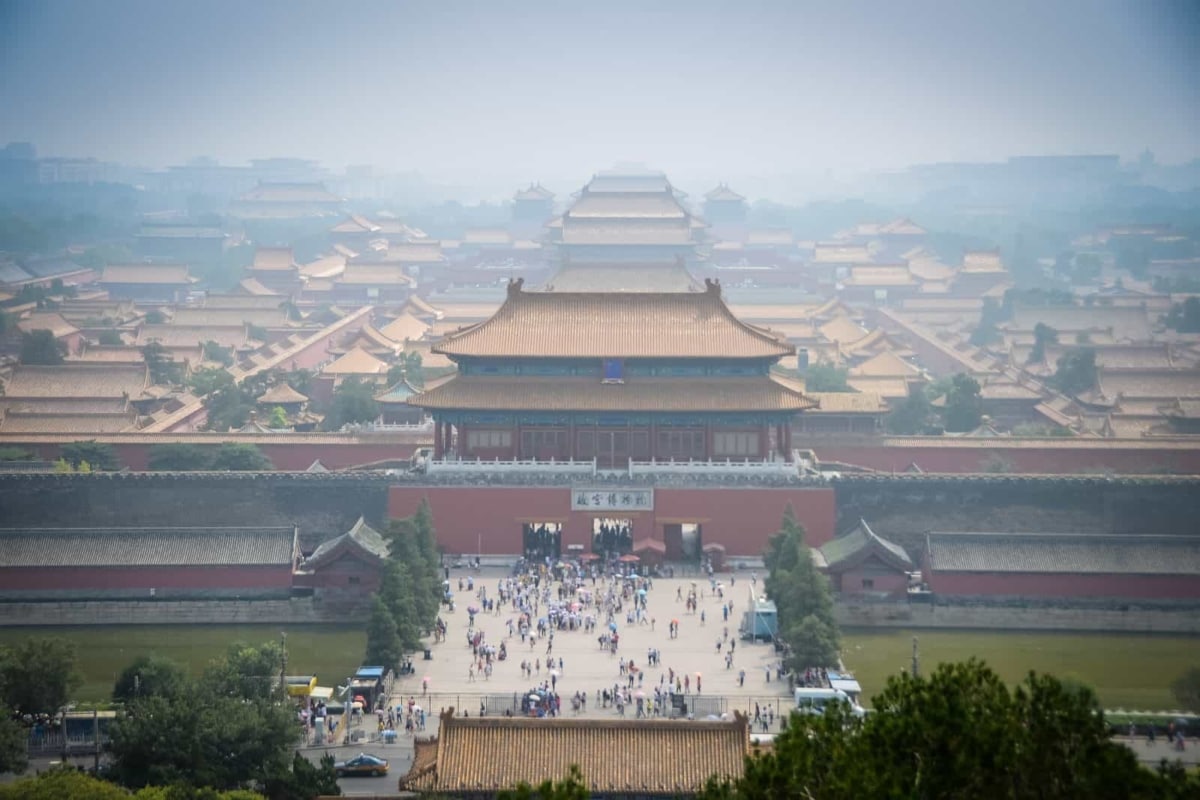Spending 2 weeks in China is enough time to do everything from the Great Wall to a bunch of hole-in-the-wall restaurants serving up the best pan-fried dumplings. But it’ll also just scratch the surface. So here’s how to make the most of your China itinerary.
The Ultimate 2 Week China Itinerary
When planning a trip to China, there are probably a handful of destinations you’re dying to check off your bucket list in just 2 weeks in China. Maybe you want to explore the colorful Buddhist temples, lotus-filled ponds, and adorable baby pandas chewing on bamboo stalks. Or perhaps you imagine walking through the bustling metropolis of towering skyscrapers and modern high rises.
Or maybe you simply crave the aromatic taste of traditional Chinese foods like pan-fried dumplings and crispy Peking duck.
And the truth is, you can do all these things with just 2 weeks in China. Although two weeks will barely scratch the surface, there is still so much to do. As one of the oldest and fasting growing civilizations in the world, China is teeming with adventures for every type of traveler.
How to Get Around China
Generally speaking, air travel is the fastest way to get around the country. Because cities and distances can be far apart, you can save a lot of time and energy by flying. The only downside is that domestic flights can be expensive, especially if booked last minute.
And while domestic flights can be faster and more convenient, traveling by bullet train is another popular method of transportation in China. Bullet trains usually run between most major tourist cities and provide a fast, comfortable way to travel long distances.
If you’re on a budget, traveling by standard railway is a cost-efficient way to go. However, local trains are often uncomfortable and extremely slow. The journey takes twice as long compared to bullet trains, which means you could be stuck in the same seat for over 24 hours.
Tickets for both types of trains can be booked the day of, but since they can quickly sell out, it’s recommended to purchase seats 20-30 days in advance.
The cheapest and most common transportation method is by bus. However, taking the bus is only practical if you are traveling to a city that’s not served by an airport or train station. Poor road conditions and unbearable traffic can make the bus journey extremely stressful.
A Sleeper bus is also available for long distance China trips, but bed space is often narrow and crowded. And while most bus coaches have bathrooms on-board, we can’t attest that they’ll be clean or even in service.
For a wide selection of train, bus and flight tickets during your China itinerary, we recommend booking directly with 12go.asia.
China Itinerary: See the Best of China in 2 Weeks
With 22 different provinces and dozens of beautiful cities, China is one of the largest countries in the world. And even if you plan an action-packed China trip, a few days in China simply won’t do it justice.
But as a first (or second) time visitor, 2 weeks in China is a reasonable amount of time to get an overview of the entire country. And if you have more time to spare, you can always stay a few days longer in each city to gain a richer understanding of the area. It’s more rewarding to spend your trip soaking in the culture rather than seeing it from the inside of a bus or plane!
Day 1 – 4: Visit Historical and Cultural Landmarks in Beijing
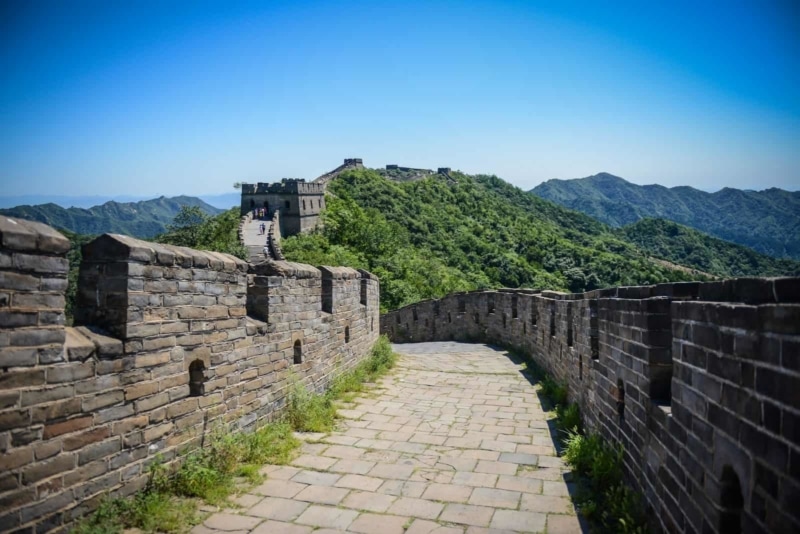
China’s capital is a bustling city overflowing with 3,000 years of culture and history. Home to some of China’s most iconic landmarks, Beijing is slowly revolutionizing itself to become an international world leader.
And around every corner, you can see how Beijing manages to blend both ancient histories with modern culture together.
Climb the Great Wall of China
No trip to the capital city would be complete without trekking the Great Wall of China, one of the seven wonders of the world. Winding through 5,500 miles of rugged mountains, the Great Wall of China is a rare glimpse into one of China’s most fascinating pieces of architecture.
A word of advice: Skip the Badaling section and head straight for Mutianyu or Jinshanling. While these spots are further away, they’re more authentic and way less crowded than the commercial, tourist trap of Badaling. That’s why you should definitely go during your China itinerary.
Explore the Forbidden City
The Forbidden City was once home to ruling Imperial emperors of both the Ming and Qing Dynasties. And although you won’t find any royal families wandering around today, the Forbidden City remains the largest palace complex in the entire world.
But with over 900 buildings and almost 9,000 individual rooms, you can’t explore everything within the Forbidden City. However, you shouldn’t miss a tour of the Hall of Supreme Harmony, the Palace of Heavenly Purity, and the Imperial Gardens.
If you’re not entirely exhausted, we recommend a short walk up to the neighboring Jingshan Park. From the top, you’ll be rewarded with panoramic views over the Forbidden City.
Relax at the Summer Palace
The Summer Palace is a beautiful park and easy day trip getaway from the bustle and congestion of the city. Built as a summer escape for the Imperial family, this park boasts a variety of Buddhist temples, landscape gardens and tree-lined lakes.
The park grounds are centered around Kunming Lake, the perfect destination for a picnic lunch or relaxing boat ride. Make sure to tour Longevity Hill, a scenic viewpoint with colorful pavilions and grand halls.
Where to Stay in Beijing
Although the capital is one of the more expensive places to stay in China, you can still find accommodation for every type of budget during your China itinerary.
Just like in most major cities, there are large, international chains in Beijing. These places have amenities such as swimming pools, restaurants with western breakfast and business centers.
But if you’re looking to step outside your comfort zone, you can spend a few days in one of the traditional hutongs. Hutongs are one-story residential buildings have been converted to inns. For an authentic, Beijing experience, hutongs are a unique accommodation experience right in the city.
- Luxury Hotels: Hotel Eclat Beijing, Legendale Hotel Wangfujing Beijing, Shangri-La Hotel Beijing, InterContinental Beijing Sanlitun
- Boutique Hotels: Beijing Pudi Hotel, Beijing Double Happiness Hotel, Michael’s House Beijing, Sofu Hotel
- Mid-Range Hotels: Ming Courtyard, Jade Hotel, Capital Hotel, Kelly’s Courtyard Hotel
- Hostels: Peking International Youth Hostel, Chinese Box Courtyard Hostel, The Great Wall Box House, Leo Hostel
How to Get from Beijing to Xi’an
The easiest (and most comfortable) way to reach Xi’an from Beijing is by bullet train. The train leaves from Beijing West Station and takes only 4.5 – 6 hours in total. Speeding through the country at 186 mph, you’ll have the opportunity to see other picturesque villages like Zhengzhou, Luoyang and Huashan from your window.
Taking a two-hour flight from Beijing to Xi’an is also possible. But with the check-in and security, it ends up taking the same amount of time as the high-speed train.
If you’re on a budget, then taking the sleeper train to Xi’an is a great option. You can choose between shared bunks or a separate compartment throughout your China itinerary. But best of all, you’ll save the cost accommodation when opting for this 12-hour train ride!
Check out routes and prices using the form below.
Day 4 – 6: Explore the Imperial Capital of Xi’an
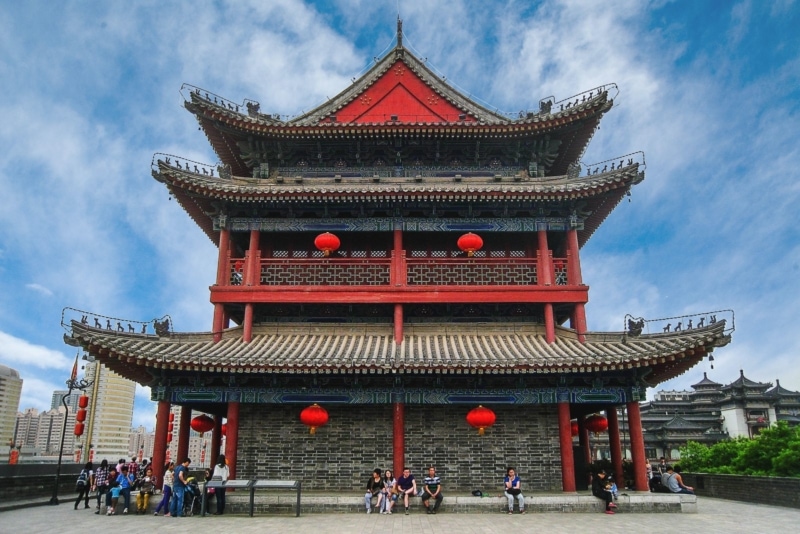
Few places in China are as culturally diverse as Xi’an. As the starting point on the Silk Road, Xi’an became an influential city home to emperors, warriors, merchants, and artists. But besides the Silk Road, most of the city’s history can be seen through its distinct architecture, making Xi’an a must stop destination in China for a few days.
Admire the Terracotta Warriors
When in Xi’an, you must tour the tomb of the terracotta warriors. Over 8,000 life-size soldiers and horses were buried more than 2,000 decades ago to protect Qin Shi Huang, the first emperor of China, in the afterlife.
And while there are still thousands of soldiers left to excavate, the terracotta army is a rare journey into the world of Ancient China.
What’s more impressive is each warrior has a different face. The level of detail on the armor, footwear, hairstyles and facial expressions is nothing short of remarkable. No two soldiers are the same, which you’ll see during your China itinerary tour!
Eat Your Heart Out in the Muslim Quarter
Although there’s no shortage of mouth-watering snacks in China, Xi’an’s Muslim Quarter is a food lover’s paradise. The sheer number of snack food stalls along the silk road can be overwhelming at first.
Here, you can find everything from beef skewers, dumplings, noodle bowls, spicy sandwiches, and local pastries. Try the Yangrou Paomo, a typical Xi’an stew made from lamb and served steaming hot with chunks of unleavened bread.
And while you’ll have an endless supply of traditional Xi’an foods at your fingertips, don’t expect any pork. After all, you are in a Muslim neighborhood!
Cycle Along the Ancient City Wall
For some of the best, panoramic views of Xi’an, stand atop the imperial 40-foot city walls that surround the city center. Built-in 1370 as a defense fortification system, the city walls were also constructed with a moat, drawbridges, steel gates and watchtowers.
Walking along the city wall is possible, but the best way to get around with a bike tour. It takes roughly two hours to cycle the perimeter of the city. Your reward: sweeping views of both modern day and ancient Xi-an from every angle.
Conquer Mt. Huashan
You won’t read about this in your travel guide! If you want to check a dangerous albeit thrilling adventure off your bucket list during your China itinerary, then hike Mt. Huashan, one of China’s most treacherous mountains. Located a few hours outside Xi’an, Mt. Huashan is famous for breathtaking views, granite peaks, and of course, it’s adrenaline-filled plank walk.
With only a thin harness chaining you to safety, you can scale the side of the 2,000-foot cliff by shuffling across a 1-foot wide, wooden plank. And while we can’t guarantee you won’t have a panic attack, we can vouch for the exceptional scenic views.
Where to Stay in Xi’an
Hotels in Xi’an are more affordable than other big cities in China, such as Beijing or Shanghai. For this reason, you should have no problem finding a clean, decent place to stay for a few days.
For first time visitors to this silk road city, consider staying within the city walls. Not only are you within walking distance to most major attractions, but you can also easily take a public bus to the terracotta warriors or other outlying neighborhoods.
And when it comes to different types of accommodation, Xi’an is home to a wide variety of hostels, hotels, and luxury resorts for every budget.
- Luxury Hotels: Sofitel Legend People’s Grand Hotel Xi’an, Shangri-la Hotel Xi’an, Gran Melia Xi’an Hotel
- Boutique Hotels: Eastern House Boutique Hotel, Xi’an 52 Hezi Hotel, Time Tunnel Designer Hotel, Simple Palace
- Mid-Range Hotels: Grand Park Xi’an, CitiGO Hotel Gaoxin Xi’an, Ramada by Wyndham Xi’an Bell Tower, Xi’an Grand Soluxe International Hotel
- Hostels: Xi’an 7 Sages Belltower Boutique Youth Hostel, Han Tang Inn Hostel, Han Tang House, Shuyuan International Party Hostel
How to Get from Xi’an to Guilin
For transport, you have two realistic options to get from Xi’an to Guilin. The fastest way is to take a two-hour flight south to Guilin Liangjiang International Airport, which is roughly 20 miles outside the city center. If you’re short on time, then flying from Xi’an is the best option.
The other, more time-consuming option is to take a bullet train. It runs only during the day and takes around 11 hours to reach the city.
Check out your options using the form below.
Day 6 – 8: Be One With Nature in Guilin
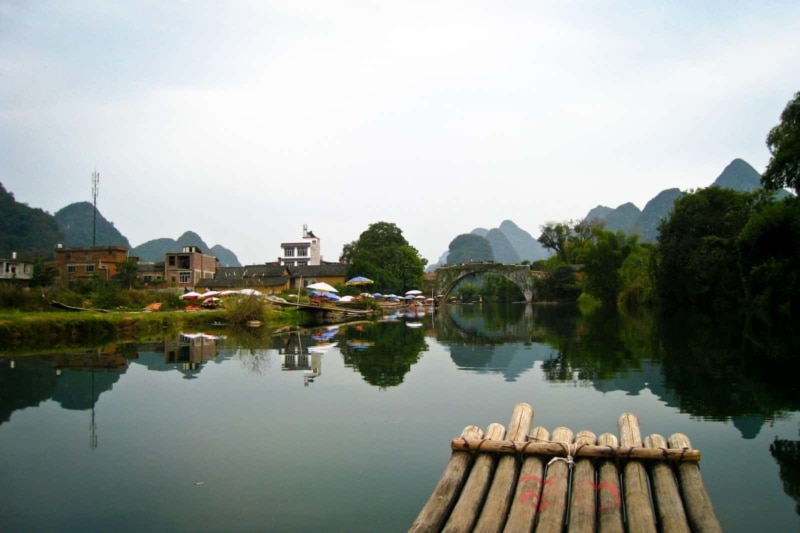
If you want to tour rolling hills, steep mountains, and tranquil lakes, then make sure to add this ancient city in the south to your China itinerary. Famous for its dramatic landscapes, Guilin is lightyears away from the hectic crowds of China’s bigger cities. It’s the perfect place to relax and explore China’s scenic and breathtaking countryside.
Admire the Buddhist Sun and Moon Pagodas
Situated in the heart of this spectacular city are the two Buddhist Sun and Moon Pagodas. The Sun Pagoda is built from copper and glows a bright, warm gold when illuminated at night. The smaller but equally impressive Moon Pagoda is made from marble and shines a bright white color.
The two Buddhist pagodas are connected by an underground tunnel that runs under Shan Lake. Although you can ride to the top of the pagodas, the best view is from the banks of the lake at night! This is a must-do tour to add to your China itinerary.
Be Dazzled Inside Reed Flute Cave
The Reed Flute Cave is one of China’s most spectacular natural phenomenons. As you take a tour underground, you’ll uncover dark caverns and rugged limestone formations that have existed over the last 180 million years!
But most impressively, the giant stalactites and stalagmites are illuminated by thousands of colorful, neon lights. This sparkling attraction brings the cave to life, and shows the beauty of the natural formations from a unique perspective!
Walk Along the Longsheng Rice Terraces
Cascading down the sides of sloping hills, the bright green, terraced rice paddies are one of Guilin’s natural gems. And with miles of tiered terraces, you’ll understand why people often refer to it as the country’s Dragon’s Backbone.
To fully explore everything the Longsheng Rice Terraces has to offer, consider taking a tour from Dazhai to Ping’an (or vice versa). It takes around 4 or 5 hours and winds you through the rice paddies and small, rural villages.
It’s important to note that the terraces are several hours outside the city center, so be prepared to take a full day trip.
Where to Stay in Guilin
Most of the attractions are outside the city, and you can easily find somewhere away from the hustle and bustle. However, staying in the city puts you in the center of restaurants and bars. Either way, try and snag a room with a view of the natural surroundings!
There are also plenty of international and western brand chains. And while these options are more expensive than smaller, local hotels, the price is still affordable compared to other cities in this China itinerary.
- Luxury Hotels: The Wing Hotel Guilin, Guilin Bravo Hotel, Sheraton Guilin Hotel, The White House Hotel Guilin
- Boutique Hotels: Joli Vue Boutique Hotel Guilin, Aroma Tea House, Sky Garden Inn, Elephant Truck Hill Hotel
- Mid-Range Hotels: Lijiang Waterfall Hotel, Guilin Bravo Hotel Grand Wing, Guilin Lakeside Inn, Guilin Oasis Inn
- Hostels: Guilin Central Wada Hostel, Sky Palace Hostel, This Old Place International Youth Hostel, Ming Palace International Hostel
How to Get from Guilin to Yangshuo
Due to their close proximity, you’ll have a variety of options to get to Yangshuo. A private car or taxi may be the most expensive option, but it can get you door to door in under 90 minutes.
A public bus can also shuttle you between both cities. The bus ride also takes under 90 minutes, and leave from the airport, bus station, or railway station.
However, we recommend taking the bullet train from to Yangshuo for this China itinerary. It’s roughly the same price as the bus and gets you into Yangshuo in just 25 minutes. Keep in mind that the train station is 20 miles outside the city center, which means you’ll have to take a taxi to your hotel.
Day 8 – 10: Soak in the Countryside in Yangshuo

This small and charming town will be one of the most beautiful spots on your itinerary. But despite its rural location, it’s remained a popular tourist destination for visitors since the 80’s.
And although you’ll find plenty of international and western places in the city center, you come to Yangshuo for the scenic countryside. It’s the perfect jumping off point on this itinerary for exploring the natural beauty of China’s landscape.
Explore West Street
Yangshuo’s oldest road is also its most famous. Paved with cobblestones and mixing both western and Qing Dynasty architecture, West Street is a lively hub for tourists and locals alike. It’s a buzzing oasis right in the middle of the Chinese countryside!
And, it’s is also home to Yangshuo’s large backpacking community. There are plenty of hostels, western restaurants, and karaoke bars to keep you entertained for several days. And for those looking to spend the night dancing, drinking, and listening to live music, this bustling district has you covered.
Bamboo Raft down the Li River
Hop aboard a private bamboo raft and tour the spectacular Li River. You can stop by different villages, dine at river-side cafes, or relax with a book to read while you soak in your surroundings. But despite the name, these bamboo rafts are made from plastic piping, which makes for a faster (and safer) ride.
The landscape is nothing short of breathtaking as your boat glides seamlessly through the river and the rugged, limestone cliffs. And with only the sound of the humming engine to distract you, you just might find a bit of tranquility and peace on a day trip down the Li River.
Climb to the Top of Moon Hill
This unusual rock formation is named after the giant moon-shaped hole carved into the arch of the cave. As you stand below it, you can marvel at the jagged stalactites that protrude down from the arch. Rock climbing is also a popular sport at Moon Hill, with over 14 distinct climbing routes available.
And for a closer view of the arch, you can ascend the 1,000 marble steps towards the top. But if you’re eager to catch a glimpse of the entire valley, you can continue the climb to the summit for the best sweeping views.
Where to Stay in Yangshuo
If you choose to spend a few days in the city center, you’ll find many hostels and hotels on the busy West Street. Since Yangshuo is a popular backpacker destination, you should have no problem finding a clean and reasonably priced dorm bed for a few days.
On the other hand, staying in one of the neighboring villages can offer a unique experience. Many resorts or inns provide a peaceful, countryside retreat away from the crowds.
- Luxury Hotels: Yangshuo Li River Resort, Yangshuo Mountain Retreat, Yangshuo Hidden Dragon Villa Hotel, VISION Hotel
- Boutique Hotels: Yangshuo C Source West Street Residence, Amari Yangshuo, Yangshuo Mountain Nest Boutique Hotel, Humble Inn Boutique Residence
- Mid-Range Hotels: West Street Hotel, Bamboo House Resort, Guifu Holiday Hotel, Yangshuo Moondance Hotel
- Hostels: En Attendant Godot Youth Hostel, The Hidden House, Yangshuo Sudder Street Guesthouse, Mountain Stream
How to Get from Yangshuo to Shanghai
While there are several ways to get from Yangshuo to Shanghai, we strongly recommend taking a bullet train or plane. The main bullet train leaves from Guilin Railway Station and takes between eight and nine hours, while the flight is around two hours.
Although a standard train might save you a few bucks, it can take upwards of 25 hours, which can be a nightmare journey if you can’t snag a sleeper bed!
Day 10 – 14: Be Dazzled by the Metropolitan Skyline of Shanghai
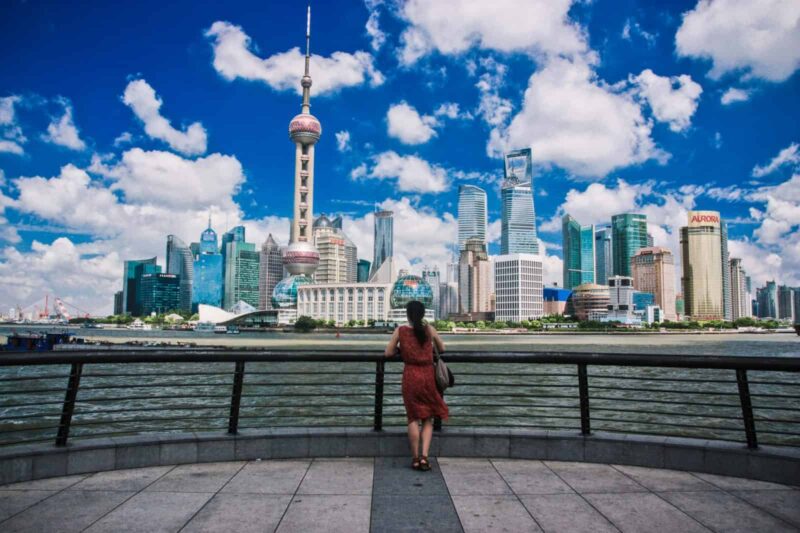
In the south, Shanghai is an urban oasis, teeming with neon lights, skyscrapers, and enough entertainment to satisfy every taste. Here, the architecture is diverse, the shopping is plentiful, and the cuisine is served fresh and piping hot.
And while it feels more like glamorous and western than most places in China, Shanghai is still a buzzing cultural hot spot. Fusing ancient traditions with modern ideas, Shanghai is the perfect destination to end your journey in China.
Stroll Along the Bund
Walking on Shanghai’s waterfront boulevard boasts some of the best views of the city. Situated south from cosmopolitan high-rises of Pudong, the Bund is the perfect place for a leisurely stroll. Not to mention, it’s also one of the best sites for people watching!
Filled with performers, tai-chi enthusiasts, and photographers, the Bund is lively at all hours of the day.
And when the sun goes down, the neon skyscrapers reflect off the Huangpu River and illuminate the night sky. Taking an evening dinner cruise is one of the best ways to experience the sparkling magic of Shanghai’s skyline.
Spend an Evening in Tianzifang
Tianzifang is a charming art district teeming with designer pop-up shops, hidden cafes and trendy restaurants. As you navigate through the labyrinth of narrow alleys and stone-framed houses, you’ll stumble across some of the coolest shops in Shanghai.
At night, students, trendsetters, and tourists flood the roads looking for cocktails, snacks, and fun times in general. Because of it’s cozy, quaint atmosphere, you’ll forget you’re even in Shanghai!
Shop on Nanjing Lu
The blazing lights of Shanghai’s most prominent shopping district can be, to put it simply, overwhelming. Luxury department stores, knock-off markets, textile shops and malls line this crowded pedestrianized area. Nevertheless, it’s an exciting and authentic Shanghainese experience that you can’t keep away from.
Nanjing Lu is a shopper’s oasis and stretches south from the Bund all the way to People’s Square. But even if you’re not into shopping, you can still enjoy the boisterous and chaotic atmosphere!
Slurp Some Xiaolongbao
Commonly known to most people as a soup dumpling, xiaolongbao is a traditional Shanghainese snack that can be found almost everywhere in the city. These cooks stuff succulent dumplings with ground pork, green onion, and ginger before folding them (with precisely 18 creases) and steaming them in a bamboo basket.
The most popular restaurant is Nanxiang, which is located in YuYuan Gardens. While it can be jam-packed (and touristy), they’ve been making xiaolongbao for over 100 years, so you know you’re getting the good stuff! You can’t miss this place during your 2 weeks in China.
Where to Stay in Shanghai
As China’s largest city, Shanghai has a large variety of hostels and hotels to choose from. You can find chic boutiques in the French Concession, opulent resorts on the bund and even dorm rooms tucked away down an alley.
While you can score good deals on rooms, the average cost of a hotel in Shanghai can be high.
- Luxury Hotels: Shanghai Mariott Hotel City Center, Sofitel Shanghai Hyland, Radisson Blu Hotel Shanghai New World, Le Royal Meridien Shanghai
- Boutique Hotels: The Yangtze Boutique Shanghai, SSAW Boutique Hotel Shanghai Bund, Les Suites Orient, Shanghai Chi Chen Boutique Hotel
- Mid-Range Hotels: Shanghai Fish Inn East Nanjing Road, Riverview Hotel on the Bund, Majesty Plaza Shanghai, City Hotel Shanghai
- Hostels: Shanghai Blue Mountain Bund Youth Hostel, Shanghai Meego Yes Hotel, Rock&Wood International Youth Hostel, Mingtown Etour International Youth Hostel
Ending Your Trip in Shanghai
Sadly, all great vacations must come to an end. And after two exhilarating weeks in China, it’s time to head back through one of Shanghai’s two international airports.
Remember to give yourself enough time to check in luggage and get through customs at the airport. Lines tend be longer compared to other airports, and can take upwards of two hours.
But as your plane soars past the city lights of Shanghai and over the Pacific Ocean, you’ll have plenty of incredible memories to take back home with you.
How Much Will 2 Weeks in China Cost?
The cost of your trip to China doesn’t necessarily depend on where you travel, but how you travel.
The Cost of Transportation in China
Getting to and around China is likely to be your biggest expense. Depending on where you’re traveling from, international flights into Beijing or other major cities can cost around $600 to $1,500 per seat.
Once you’re in the country, you’ll have a variety of options to travel from city to city. Domestic flights can save time and energy, but they will almost always cost more than ground transportation. On the other hand, trains are much more affordable (especially the slower, regional trains) and can be nicer than other ground travel options for your 2 weeks in China.
Taxis are also relatively cheap, even in big cities like Beijing and Shanghai. But most places are well connected by subway, which is affordable and surprisingly easy to navigate.
The Cost of Accommodation in China
Accommodation costs vary greatly depending on the type of place you are staying. Luxury hotels can cost almost as much as they do in western countries but come with all the comforts that you’d expect.
If you’re on a budget, you’ll find plenty of mid-range hotels in every city for your trip to China. These can cost anywhere from $30 to $100 a night and are usually reasonably spacious and clean.
Hostels are a popular choice if you want to spend the least amount for accommodation. In big cities, you can find shared dorm rooms for around $20, while smaller towns can be as low as $10 a night.
The Cost of Food and Drinks in China
Everyone around the world knows China for its cuisine, and you can find a range of restaurants when traveling through the country.
Snack food is delicious, cheap, and can be found on almost every corner. From dumplings to meat skewers to pancakes, these snacks are a great way to sample the local culture while also sticking to a budget. Best of all, it will only cost you a few bucks!
Keep in mind that international or western restaurants will almost always cost more than Chinese restaurants. The only exceptions are Chinese delicacies like Peking duck, shark fin soup, and other luxury seafood dishes.
Travel Insurance in China
Travel insurance is one of the most important, if not the most critical thing to have on your China itinerary. Whether you come down with a bad case of food poisoning or break your leg in a scooter accident or during another activity in China itinerary, you’ll be glad to have travel insurance.
Not only does travel insurance in China cover the cost of your medical treatments, but it also protects you against other incidents that might occur.
Your $800 iPhone that some thief swiped from your pocket on the train? Or that thunderstorm that canceled your flight to Beijing? Travel insurance covers both of those situations, too.
The last thing you want is to have thousands of dollars in medical bills or pay for your lost or stolen goods straight out of pocket. And since it only costs a fraction of your total trip, there’s no excuse to travel without it.
There are plenty of travel insurance companies to choose from, but some policies and benefits are better than others. We recommend World Nomads, the leading travel insurance for all types of backpackers and travelers.
Final Thoughts
China is brimming activities for every type of traveler. From the great outdoors to the Great Wall, you can spend a memorable 2 weeks in China.
This China itinerary highlights the main attractions for a two-week trip, but you should feel free to make it your own! Take that last-minute trip to the neighboring village for a few days, explore the back alleys of the city and get off the beaten path. You never know what awaits you around every corner.
Because really, there’s no right or wrong way to see China.
READ MORE:
China Itinerary FAQs
-
How many days is enough for China?
I recommend taking at least 2 weeks to visit China.
-
Which month is best to visit China?
May is one of the best months to travel in China.
-
Is China cheap for vacation?
Yes, China is a very affordable vacation destination.
-
Is it safe to go to China right now?
Yes, it is safe to travel to China.
-
What time of year is cheapest to go to China?
January, February, and September are the cheapest times to go to China.
